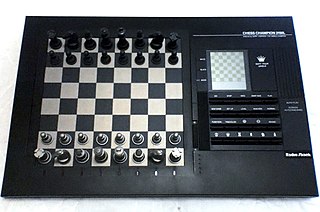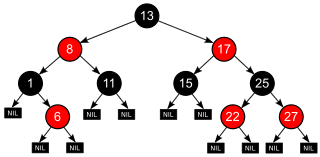 W
WComputer chess includes both hardware and software capable of playing chess. Computer chess provides opportunities for players to practice even in the absence of human opponents, and also provides opportunities for analysis, entertainment and training.
 W
W W
WThe 0x88 chess board representation is a square-centric method of representing the chess board used by some chess programs. The number 0x88 is a hexadecimal integer (13610, 2108, 100010002). The rank and file positions are each represented by a nibble (hexadecimal digit), and the bit gaps simplify a number of computations to bitwise operations.
 W
WBoard representation in computer chess is a data structure in a chess program representing the position on the chessboard and associated game state. Board representation is fundamental to all aspects of a chess program including move generation, the evaluation function, and making and unmaking moves as well as maintaining the state of the game during play. Several different board representations exist. Chess programs often utilize more than one board representation at different times, for efficiency. Execution efficiency and memory footprint are the primary factors in choosing a board representation; secondary considerations are effort required to code, test and debug the application.
 W
WIn computing, tree data structures, and game theory, the branching factor is the number of children at each node, the outdegree. If this value is not uniform, an average branching factor can be calculated.
 W
WChess Crusade is a video game of the board game genre developed in 2008 by British studio Slam Games. Chess Crusade follows the game of chess featuring animations between chess pieces, as these medieval themed characters confront each other on the chess board. As the pieces move around the board, they meet with intense animated combat moves in an effort to overpower or be trembled.
 W
WIn computer chess, a chess engine is a computer program that analyzes chess or chess variant positions, and generates a move or list of moves that it regards as strongest. A chess engine is usually a back end with a command-line interface with no graphics or windowing. Engines are usually used with a front end, a windowed graphical user interface such as Chessbase or WinBoard that the user can interact with via a keyboard, mouse or touchscreen. This allows the user to play against multiple engines without learning a new user interface for each, and allows different engines to play against each other. Many chess engines are now available for mobile phones and tablets, making them even more accessible.
 W
WDeep Blue versus Garry Kasparov was a pair of six-game chess matches between the world chess champion Garry Kasparov and an IBM supercomputer called Deep Blue. The first match was played in Philadelphia in 1996 and won by Kasparov by 4–2. The second was played in New York City in 1997 and won by Deep Blue by 3½–2½. The 1997 match was the first defeat of a reigning world chess champion by a computer under tournament conditions.
 W
WDeep Blue–Kasparov, 1996, Game 1 is a famous chess game in which a computer played against a human being. It was the first game played in the 1996 Deep Blue versus Garry Kasparov match, and the first time that a chess-playing computer defeated a reigning world champion under normal chess tournament conditions.
 W
WGame 6 of the Deep Blue–Kasparov rematch, played in New York City on May 11, 1997 and starting at 3:00 p.m. EDT, was the last chess game in the 1997 rematch of Deep Blue versus Garry Kasparov.
 W
WAn endgame tablebase is a computerized database that contains precalculated exhaustive analysis of chess endgame positions. It is typically used by a computer chess engine during play, or by a human or computer that is retrospectively analysing a game that has already been played.
 W
WGame Over: Kasparov and the Machine is a 2003 documentary film by Vikram Jayanti about the match between Garry Kasparov, the highest rated chess player in history, the World Champion for 15 years (1985–2000) and an anti-communist politician, and Deep Blue, a chess-playing computer created by IBM. It was coproduced by Alliance Atlantis and the National Film Board of Canada.
 W
WGNOME Chess is a graphical front-end featuring a 2D and a 3D chessboard interface. GNOME Chess does not include a chess engine of its own, so to play against the computer a third party chess engine must be present. Most Linux distributions package GNU Chess as the default chess engine with it. Additionally GNOME Chess supports third party chess engines, with known ones automatically detected.
 W
WMedieval Kings Chess II (MKC2) is a networked multiplayer chess game developed and published by Magmic Games primarily for mobile devices. This game was originally released in 2005 for BlackBerry, but has since been ported to Java and Windows Mobile handsets.
 W
WMephisto was a line of chess computers sold by Hegener & Glaser (H+G). In addition to integrated travel and sensory computers, they also sold a line of modular electronic autosensory boards which could accept different program, processor, and display modules.
 W
WThe Shannon number, named after the American mathematician Claude Shannon, is a conservative lower bound of the game-tree complexity of chess of 10120, based on an average of about 103 possibilities for a pair of moves consisting of a move for White followed by a move for Black, and a typical game lasting about 40 such pairs of moves.
 W
WTurochamp is a chess program developed by Alan Turing and David Champernowne in 1948. It was created as part of research by the pair into computer science and machine learning. Turochamp is capable of playing an entire chess game against a human player at a low level of play by calculating all potential moves and all potential player moves in response, as well as some further moves it deems considerable. It then assigns point values to each game state, and selects the move resulting in the highest point value.